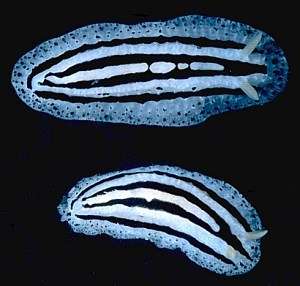
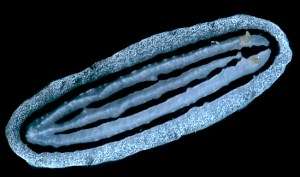
Phyllidiopsis striata
Bergh, 1888
Order: NUDIBRANCHIA
Suborder: DORIDINA
Family: Phyllidiidae
DISTRIBUTION
Known from the central and western Pacific Ocean and Indian Ocean.
PHOTO
UPPER: 16 m depth, Phi Phi Island, southern Thailand, 1 Dec. 1989, dorsal view of 10 and 9 mm specimens (Brunckhorst, 1993: Plate 8D); LOWER: 6 m depth, Bile Bay, Guam, 14 July 1988, dorsal view of 19 mm specimen (Brunckhorst, 1993: Plate 8E).
Notes compiled partly from Brunckhorst, 1993:
Phyllidiopsis striata is easily distinguished in the field by its three low, white longitudinal dorsal ridges, white mantle skirt, four black longitudinal bands and translucent straw-coloured ['lemon-yellow' Brunckhorst, 1993] rhinophores.
Phyllidiopsis phiphiensis has two white ridges and three black bands (three white ridges and four black bands in P. striata), black spots on the mantle margin, white rhinophores (lemon yellow in P. striata) and is white ventrally (grey and black in P. striata). Phyllidiopsis annae has three blue ridges, and black rhinophores. Phyllidiopsis sphingis has three irregular white ridges which are usually separated (straight ridges join at the anus in P. striata), iridescent blue coloration to the mantle skirt, cream rhinophores (white mantle skirt and yellow rhinophores in P. striata) and a cream to white foot sole (grey in P. striata).
Reference:
• Brunckhorst, D.J. (1993) The systematics and phylogeny of Phyllidiid Nudibranchs (Doridoidea). Records of the Australian Museum, Supplement 16: 1-107.
Rudman, W.B., 1999 (August 1) Phyllidiopsis striata Bergh, 1888 . [In] Sea Slug Forum. Australian Museum, Sydney. Available from http://www.seaslugforum.net/find/phylstri
Related messages
Variant of Phyllidiopsis striata from Indian Ocean
June 14, 2007
From: Hugues and Sandrine Flodrops

Dear Bill,
To accompany my message about typical Phyllidiopsis striata [#19311 ].
Here are photos of two others which seem to be a bit different - like the photo of Marina Poddubetskaia (message #8318 ).
We have observed on three specimens that the two external black lines aren't connected at the posterior end. Is it a variation or a juvenile characteristic?
The first specimen [upper photo ] was taken in Mauritius, 20 november 2006, Place: Ilot Tamarin, Town: Flic and Flac, Depth 15 metres, size:about 5 mm.
The second specimen [lower photo] was taken in Reunion, date observed: 16 january 2007, place "Sec Jaune", Town: Saint-Leu, Depth 18 metres, size about 6-7mm. Photographer: Hugues Flodrops
Thanks for your thought.
Best regards.
Hugues and Sandrine.
hugues.flodrops@wanadoo.fr
Flodrops,H.S., 2007 (Jun 14) Variant of Phyllidiopsis striata from Indian Ocean. [Message in] Sea Slug Forum. Australian Museum, Sydney. Available from http://www.seaslugforum.net/find/19312
Dear Hugues and Sandrine,
Thanks for these photos. I suspect we still have some more to learn about this group of phyllidiids. Certainly in typical P. striata the outer black lines join posteriorly and sometimes anteriorly as well. The same is the case with P. annae, which can also have black spots around the mantle edge. The difference between these two species is that P. annae has black rhinophores while P. striata has white or rather, colourless rhinophores. What they have in common is three longitudinal ridges separating the 4 black lines. Phyllidiopsis phiphiensis looks quite like your photos here, but it differs in having only two longitudinal ridges.
But our knowledge of these species is based mainly on a very few preserved specimens so it's possible we have it wrong. Perhaps the colour of the rhinophores is variable, or the number of ridges? I guess the only thing I can say is keep looking for variablity and for behavioural clues. Perhaps you will find two colour forms mating, or perhaps different colour forms feeding on different sponges or laying different egg ribbons.
Best wishes,
Bill Rudman
Typical Phyllidiopsis striata from Reunion Island
June 14, 2007
From: Hugues & Sandrine Flodrops
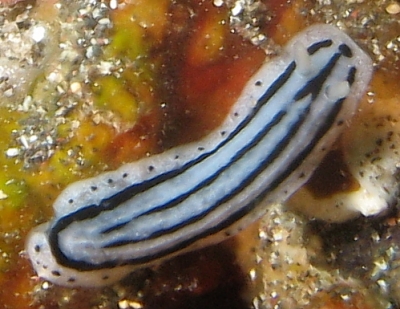
Dear Bill,
To illustrate the doubts I express in my other message [#19312 ], here are two specimens of typical Phyllidiopsis striata (Bergh 1888). We can observe the white mantle skirt and four black longitudinal bands. Also, we see black spots around the mantle edge and the two external black lines are connected at the posterior end.
The upper photo was taken at "Pain de sucre" Saint-Gilles, Reunion Island, depth 12 m, size about 9 mm, date observed: 20 december 2006.
The lower photo was taken at Saint-Leu, Reunion Island, depth 10 m, size about 10 mm, date observed: 12 December 2006. Photographer: Hugues Flodrops.
Thanks for your comments and best regards.
Hugues and Sandrine
hugues.flodrops@wanadoo.fr
Flodrops,H.S., 2007 (Jun 14) Typical Phyllidiopsis striata from Reunion Island. [Message in] Sea Slug Forum. Australian Museum, Sydney. Available from http://www.seaslugforum.net/find/19311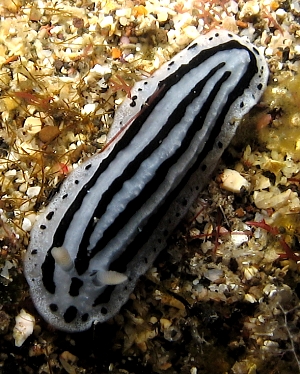
Dear Hugues and Sandrine,
Thanks for the photos. Seee my comments in your other message [19312 ]
Best wishes,
Bill Rudman
Phyllidiopsis phiphiensis or P. striata?
February 8, 2006
From: Kee Alfian B. Abdul Adzis

Hi there, i am having trouble with confirming the species, either Phyllidiopsis phiphiensis or P. striata. Can anybody please help me to confirm the identification.
Locality: Pulau Perak, Kedah, Malaysia. Malacca Straits.Depth: 5-8 meters. Length: 18 mm. 23 January 2006. coral ecosystem (wall). Photographer: Kee Alfian
Kee Alfian
alfian@ukm.my
Kee Alfian A.A., 2006 (Feb 8) Phyllidiopsis phiphiensis or P. striata?. [Message in] Sea Slug Forum. Australian Museum, Sydney. Available from http://www.seaslugforum.net/find/15746Dear Kee Alfian,
This is P. striata. If you look at the Fact Sheets for the two species you will see that P. striata has four black lines and P. phiphiensis has three. P. striata does not always have black spots around the edge but if you look at earlier messages on the Forum, you will see they do occur quite often.
Best wishes,
Bill Rudman
Phyllidiopsis striata from Palawan, Philippines
June 13, 2005
From: Michael Jimenez
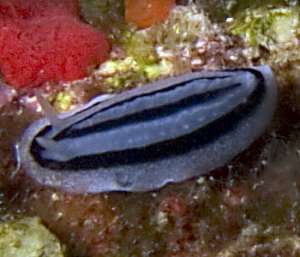
I found this small subject in the Sulu Sea about 40 minutes away from the city of Taytay, Palawan. Looks like a Phyllidiopsis striata. Sorry for the blurry pic.
Locality: Isla Blanca, Palawan, Philippines. Sulu Sea. Depth: 25 feet. Length: 1 inch. 1 April 2005. Coral and sponge-encrusted reef. Photographer: Michael Jimenez
Mike
mpj17@pacbell.net'
Mike Jimenez, 2005 (Jun 13) Phyllidiopsis striata from Palawan, Philippines. [Message in] Sea Slug Forum. Australian Museum, Sydney. Available from http://www.seaslugforum.net/find/13554Thanks Mike,
Bill Rudman
Phyllidiopsis striata from South Africa
June 7, 2005
From: Colin Ogden
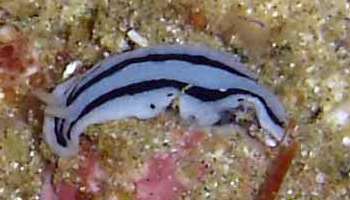
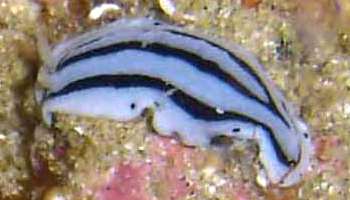
Hi Bill,
Is this a Chromodoris boucheti? It appears different to me. It has a few black spots on the body as well as the gills appear to be absent.
I have included 2 photos of this nudi.
Locality: Sodwana Bay, South Africa, Indian Ocean. Depth: 30 m. Length: 30 mm. 01 June 2005. Rock/sponge reef. Photographer: Colin Ogden
Colin Ogden
scubaco@iafrica.com
Ogden C M, 2005 (Jun 7) Phyllidiopsis striata from South Africa. [Message in] Sea Slug Forum. Australian Museum, Sydney. Available from http://www.seaslugforum.net/find/13936Dear Colin,
Your are right in thinking it is not C. boucheti. The lack of dorsal gills is a good indication. This is Phyllidiopsis striata, a member of the Family Phyllidiidae, which all lack dorsal gills.
Best wishes,
Bill Rudman
Re: Blue 'sponge' from Reunion
November 9, 2002
From: Marina Poddubetskaia
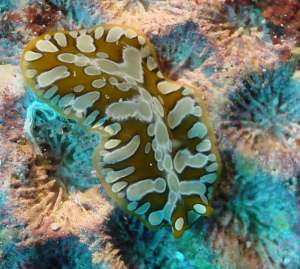
Dear Bill,
Unfortunately, I don’t think the bluish patches are a sponge. They are just the badly enlightened parts of the relief. In fact, usually, I’m using an external low powered spotlight instead of my camera’s strobe which makes my photos overexposed.
Have a look at the joined photo with the flatworm Pseudoceros scintillatus on a dead coral : it illustrates very well what happens.
Best wishes,
Marina.
nembro@nembro.info
Dear Marina,
I'm not having much luck with potential sponges! My yellow sponge turns out to be an alga and the blue one an exposure problem.
Cheers,
Bill Rudman
Phyllidiopsis striata from Reunion
November 7, 2002
From: Marina Poddubetskaia
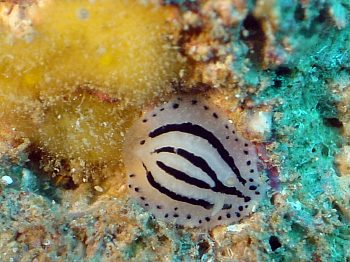
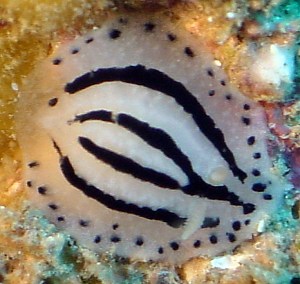
Dear Bill,
Here is a photos of what I think is Phyllidiopsis striata. This animal was found under a dead coral and photographed on it. I read on your Forum that lemon-yellow rhinophores is one of characteristics of this species. But my animal has the white ones. Also, last year in Reunion I saw larger specimens of this species and all of them had white rhinophores. What do you think about it?
Date: October 10, 2002
Location: St-Leu, Reunion Island, Indian Ocean
Site: Les arches
Depth: 12m
Size: 6mm
Photos: Marina Poddubetskaia - Nembro website
Best wishes,
Marina.
nembro@nembro.info
Poddubetskaia, M., 2002 (Nov 7) Phyllidiopsis striata from Reunion. [Message in] Sea Slug Forum. Australian Museum, Sydney. Available from http://www.seaslugforum.net/find/8318Dear Marina,
This is Phyllidiopsis striata. Brunckhorst (1993) described the rhinophores as 'lemon-yellow' but I agree it is not a good descripton of their colour. They are what is best described as translucent straw-coloured. They have a yellowish tinge which distinguishes then from translucent white or opaque white rhinophores. The description on the Fact Sheet is a summary of Brunckhorst's description. I have modified it. I am afraid that sometimes it is difficult to describe the colour of a specific object accurately, and even more difficult when the description is translated from one language to another.
I have included a view of the slug to show its background 'environment'. It is possible that the yellowish sponge is its food, but I am curious about the bluish patches. They are present in some of your other photos. Can you remember what this was? A thin layer of sponge perhaps?
Best wishes,
Bill Rudman
Phyllidiopsis striata from west Malaysia
June 20, 2002
From: Kheong Sann Chan
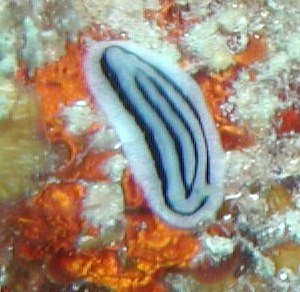
Here is another nudibranch from Pulau Dayang off the east coast of west Malaysia.
Location: Pulau Dayang, Dayang Channel
Date: 8 June 2002, 1130hr
Depth: 10m
Kheong Sann Chan
kschan@mail.dsi.nus.edu.sg
Chan, K.S., 2002 (Jun 20) Phyllidiopsis striata from west Malaysia. [Message in] Sea Slug Forum. Australian Museum, Sydney. Available from http://www.seaslugforum.net/find/7213Thanks Kheong,
This is Phyllidiopsis striata.
best wishes,
Bill Rudman
Tonga Records: Phyllidiopsis striata
May 29, 2001
From: Don Barclay
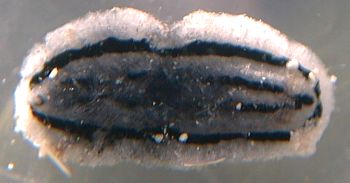
Bill,
Here is the lone photo I took of Phyllidiopsis striata, from Utungake Island, Vava'u, Tonga in February of 2001. It's not a good photo but just in case it turns out to be something else : ).
Cheers,
Don
n5ols@samoatelco.com
Barclay, D., 2001 (May 29) Tonga Records: Phyllidiopsis striata. [Message in] Sea Slug Forum. Australian Museum, Sydney. Available from http://www.seaslugforum.net/find/4419Thanks Don,
Even photos you feel are not good can be valuable, especially in cases like this where there are a number of similar-looking species. By posting the photo on the Forum it means the record can be rechecked if the taxonomy of the genus is revised.
Bill Rudman.
Phyllidiopsis striata from Lady Musgrave Isl.
February 10, 2001
From: David Harasti
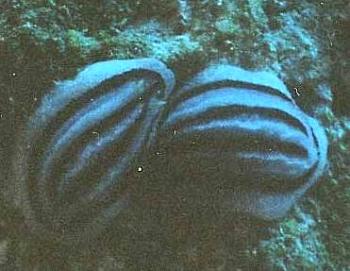
Hi Bill,
This shot was taken on Lady Musgrave Island [Great Barrier Reef, Qld, Australia] in January of this year. Unfortunately my strobe didn't fire so it's not the best shot. The stripes were a bright blue and black on the species. Both species was about 1cm long. I think it could be Phyllidiopsis striata (from Coleman 1984). Am I correct?
Thanks,
David
davidh@dynamite.com.au
Harasti, D., 2001 (Feb 10) Phyllidiopsis striata from Lady Musgrave Isl.. [Message in] Sea Slug Forum. Australian Museum, Sydney. Available from http://www.seaslugforum.net/find/3720Dear David,
Yes you're right. There are a group of similarly looking species but P. striata has these pale coloured rhinophores. It looks like these two may be mating.
Bill Rudman
Phyllidiopsis striata from South Africa
August 23, 2000
From: Valda Fraser

Dear Bill
Phyllidiopsis .... but who? Can you help?
Locality: Sodwana, north coast KwaZulu-Natal - 25m, SOUTH AFRICA
Date: Aug 2000
Size: 12mm
Thanks.
Regards
Valda Fraser
iti04937@mweb.co.za
Fraser, V., 2000 (Aug 23) Phyllidiopsis striata from South Africa. [Message in] Sea Slug Forum. Australian Museum, Sydney. Available from http://www.seaslugforum.net/find/2899Dear Valda,
I am pretty sure that this is Phyllidiopsis striata but to be more confident it would be nice to know the colour of the rhinophores which should be translucent white or yellowish. Another species which looks very like this but with black rhinophores is Phyllidiopsis annae but it hasn't been found in your part of the world as yet.
Best wishes,
Bill Rudman.
Partly yellow Phyllidiopsis striata? from Thailand
April 8, 2000
From: N. Sittithaweepat
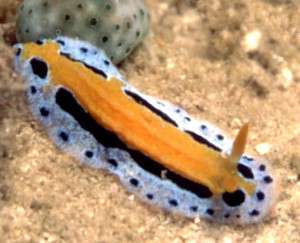
Dear Bill
I am not sure whether or not this specimen is Phyllidiopsis striata. So could you please identify it for me.
Thank you for your kindness again
Narongpon
chromodorid@thaimail.com
Sittithaweepat, N., 2000 (Apr 8) Partly yellow Phyllidiopsis striata? from Thailand. [Message in] Sea Slug Forum. Australian Museum, Sydney. Available from http://www.seaslugforum.net/find/2209Dear Narongpon,
This is another interesting find. Can ypou please give me some imformation on where it was photographed.
It certainly has similarities to Phyllidiopsis striata, particularly in having three longitudinal ridges on the mantle. If you look at the photos from Erwin Koehler of animals from the Maldives you will see black spots around the mantle edge like in your specimen.
However, we can't ignore the bright yellow region in the midline of your animal and the absence of the two inner black lines of P. striata. Another species or colour form from the Maldives which I am tentatively calling it Phyllidia sp. 1, may be related. It is yellow with black longitudinal lines.
A comment I made about that species: "If it wasn't bright yellow I would say that it was one of the striped species of Phyllidiopsis such as P. striata or P. phiphiensis" may in fact be so. One possibility is that juveniles are yellow and the grow blue as they age. That doesn't explain the lack of black lines in this animal from Thailand.
Have you any idea of its size please? It would be nice to know if you find any colour variations.
Best wishes,
Bill Rudman.
Phyllidiopsis striata from the Maldives
August 2, 1999
From: Erwin Koehler
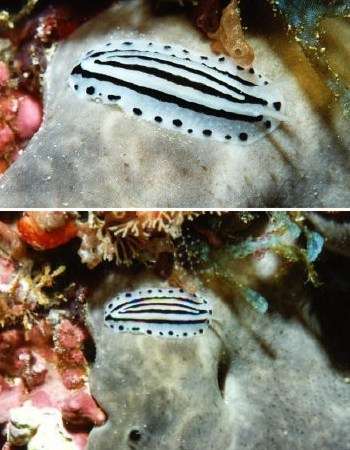
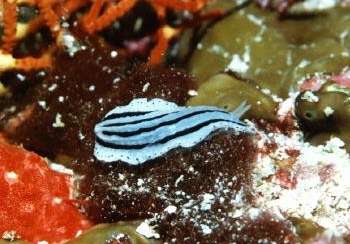
Bill,
These are from the Maldives, are they Phyllidiopsis striata?
UPPER & MIDDLE PHOTOS: Ellaidhoo Is., divesite "Orimas Faru", Nov. 23, 1996, depth 14m, size about 1,5 cm. I think it was feeding on that sponge.
LOWER PHOTO: from the Maldives, Ellaidhoo Is., housereef, Nov. 20, 1996.
Erwin
Medslugs.Koehler@t-online.de
Koehler, E., 1999 (Aug 2) Phyllidiopsis striata from the Maldives. [Message in] Sea Slug Forum. Australian Museum, Sydney. Available from http://www.seaslugforum.net/find/1143Dear Erwin,
I knew that the time would come when I would get a message which would need me to put the species of Phyllidopsis on the Forum.
Your animal certainly look like Phyllidiopsis striata. They have similarities to Phyllidiopsis phiphiensis, especially in the black spots around the mantle edge, but the three ridges and four black bands, and the pale rhinophores, are characteristic of Phyllidiopsis striata.
The sponge photo could be of potential interest for us to watch out for in the future. For comparison, I have posted pages on all the species of Phyllidopsis.
Best wishes,
Bill Rudman.
